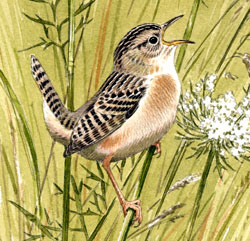Breeding Bird Atlases (BBA)
Find a Bird - BBA1
Breeding Bird Atlas 1 Species Accounts
Sedge Wren
Cistothorus platensis
State Status
Endangered
Egg Dates
May 25 to late July
Number of Broods
one or two

Formerly an uncommon and local nester, the Sedge Wren is now one of our rarest breeding species and is not recorded every year. The erratic habits of this retiring bird defy logic. Perfectly suitable habitat will support one or more pairs one year, and then no pairs will be present the following season even though conditions appear unchanged. Most breeding records in the past quarter-century have been concentrated in the vicinity of the Connecticut River valley. At one time, the species was encountered regularly in portions of eastern Massachusetts, even in the vicinity of Boston, but much of the habitat has since been drained and developed or otherwise altered.
Migrants are likely to appear during the third week of May. However, prospecting males may appear at any time in June or early July. The preferred habitat is wet meadows, but territories will sometimes be established in cultivated fields of hay or Alfalfa. Contrary to its former name, Short-billed Marsh Wren, this species seldom resides in actual marshes, where cattails and bulrushes predominate, but may on occasion occupy the drier edges of grass or sedge meadows.
The male selects a low bush or prominent grass stalk as a perch from which to repeatedly deliver his song, which consists of several sharp introductory staccato notes followed by a descending chatter. Territorial males sing throughout the day, most intensely in the morning and evening, and also frequently at night. Between song bouts, the wren creeps mouselike through the meadows in search of food and is nearly impossible to detect.
Perhaps more than any other species, the Sedge Wren is renowned for its construction of dummy nests. Such structures, built by the male, even in the absence of a female, are globular in shape and loosely made of dried grasses. The active nest, built by the female, is a better constructed ball of dry and green grasses with an opening on the side and a lining of fine grasses, catkins, and feathers. It is well concealed and usually placed no more than 1 or 2 feet above the ground or water. Four eastern Massachusetts nests were located as follows: 2 were in freshwater marshes on the side of tall grass tussocks, 2 feet and 1 foot above the water, respectively; 1 was in a damp meadow in the base of a grass tuft a few inches above the ground; and 1 was in short green marsh grass 4 inches above the mud (ACB).
A clutch of four to eight (average six or seven) white eggs is incubated by the female for 12 to 14 days. The young remain in the nest for another 12 to 14 days, during which time they are fed by both parents, although the female does the larger share. Two broods may be reared, but in many cases a pair raises only one because many nesting efforts are not initiated until late June or even early July. In such cases, fledged young may not be present until August. Late nests in hay fields are sometimes destroyed during harvesting in July.
There is little recent specific information about the Sedge Wren in Massachusetts. In 1973, a year before the Atlas project, breeding was confirmed in a wet hay field in Hadley. A male was located on June 21, and two birds were present 3 days later. Sightings continued until September 23, and at least one adult was seen carrying food (Gagnon). The following year, during the Atlas period, no birds returned to this field, but nesting was confirmed at a nearby location. The second Atlas confirmation occurred in 1976 in Blandford. Two pairs of wrens were recorded from July 5 to August 15 at an abandoned Beaver pond, partly flooded and vegetated with tall sedges and marsh grasses. On July 25, one of the birds was observed carrying food.
In 1977, one male was seen on June 22 at the same location, but he did not remain (Kellogg). After the Atlas period, two or three singing males established themselves in a hay field in Harvard from July 13 to 20, 1985. Unfortunately, heavy disturbance by birders and mowing of the field ended hopes for successful nesting.
A few records of fall migrants away from nesting sites indicate that Sedge Wrens are on the move from mid-September until early October. They may even sing occasionally during fall migration. The bulk of the population winters in coastal areas in the southern United States. There are two recent state winter records: one from Cape Cod and the other from Nantucket.
The Sedge Wren is listed as an endangered species in Massachusetts.
Map Legend and Data Summary
Atlas 1 data collected from 1975-1979


Note: very rare, local, and erratic in wet meadows and moist hay fields
Richard A. Forster



